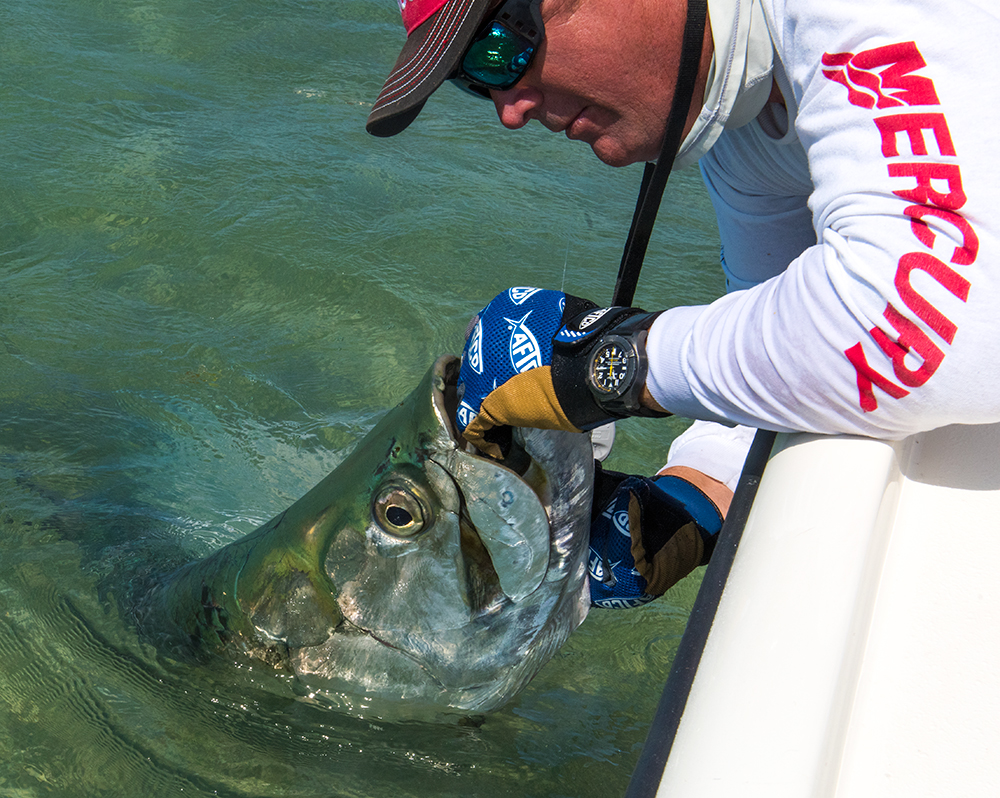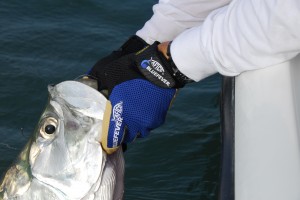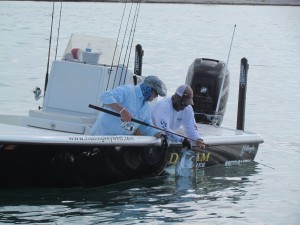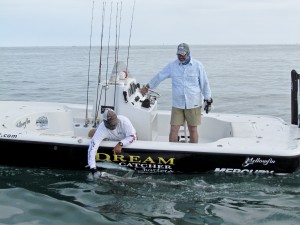Properly Release a Tarpon
Helping the resource stay alive by using good release techniques on tarpon.
Tarpon, Strong Fish Interestingly Enough a Delicate Fish.
Through the years I have been fishing for tarpon I have seen some changes in the way we as fishing guides and anglers handle a spent or fought out tarpon along side the boat. These days the tarpon in winning the battle of abuse boat side with techniques we have developed over the years to make it easier on them. I can remember watching other fishing guides use flying gaffs to hit a spent fish in the harbor to subdue him and make a show for the anglers on board. I myself have used a lip gaff to handle large fish along side. These days my tarpon handling tools are located right at the end of my arms.
Let me explain. Ok, we are at the end of the fight. The Tarpon is spent. He has shown the belly, given up the ghost, asked for release. It’s time to make your move to release him. There are two methods we use here at Dream Catcher Charters. The first is not very good for the photo op, the second, well, its a bit of a struggle but if done right gives the fish a true fighting chance for release and gets our client a great photo for their catch and keeps us within the grey areas of the law.
1. The IGFA release. IFGA rules state. A tarpon is considered a catch if the guide, angler or mate touches the leader, thats it. Easy enough. get close, grab leader, Pull…. done… This can be done early on in the fight. I can remember times when I was fishing tournaments that we would hook the fish, and my angler would keep tension on the tarpon as I moved in on the fish with the boat almost running the fish over. Right as the leader showed over the deck I would dive for the leader and pull, most of the time the hook would bend and pop out of the fish, sometimes the line would break both ways the fish is fresh and way good for going on about his business and as an angler you can feel good about the release.
Two advantages to this line of thinking. One, the fish is 100% good to go for release. Two, I can get right back into the line up and hit more numbers of fish to increase points or more times for my angler to “hook up” as many like to do. Neither are good for photo ops for the exception of jumping tarpon.
2. The “I Gotta get the photo” release. For newbies fishing tarpon for the first time, this is almost a guarantee. He wants the shot with the fishes face and his all cuddly to show off his catch. Who can blame him. He just paid x amount of money to go get this fish and any where else in the world that you hunt or fish, you get your photo with the prize.
There is a LAW.. that needs to be understood here for all of this to happen. In the state of Florida is is unlawful to harvest or possess a tarpon unless a tarpon tag (purchased from the state) is on board and can be attached to the fish. Now, this leads us to questions about what is harvested or possessed? We need to get the hook out right? So, in this line of thinking here is what we do to make everyone happy.
Fish is done, he has given you the high sign that he has given up the fight and ready to be handled. Many times this will be indicated by the lack of fight the fish may have. There are some high signs such as showing the belly or lazy half rolls. My favorite time to hit them is a little earlier in the fight where the fish tries to roll but my angler pulls the rod down and under his belly to try and pull the fish backward. This may cycle a few times but as soon as the fish shows me she is unable to fight that line and going a bit backward or just stalling I go for the leader. Generally on the Port (left) side of my boat as I am right handed for the following maneuver.
Once I get my hand on the leader and the fish is along side the boat, my angler stands behind me rod up over my head I use the outside of my hand with a glove to leader the fish, then with my right hand (gloved) I go for the lower jaw of the fish and grab hold. This is a very intense moment for me and the fish. Here is where you can display to the fish a moment of power and confidence to convince it not to fight. If you go in on this move without that confidence, the fish will own you and one of you might get hurt. Grab the jaw make it happen. Once I secure the jaw with one hand I usually put both hands on it and its over. I do not lift the whole fish out of the water, I just lift it to the gills. It is not good for your back or the fish to lift them from the jaw for the full weight of their body, especially bigger fish. Once the fish feels his gills out they seem to just hang there. This is your time to get your photo.
For the photo I position the angler in front of me or beside me so they can be in the shot with the fish.
Another option for the photo is positioning the boat on a flat. I will fight the fish to a flat and put my power pole down to secure my positioning. Then proceed with grabbing the fishes leader as mentioned in number 2. On the flat I will get out of the boat with my angler, leaving the fish in the water as we have a third person taking the photo from the boat. Be careful not to step on anything and watch out for bull sharks in search for breakfast.
Now for the release. The photo op should have been very quick and the tarpon needs to be back in the water gills and all. Don’t let the fish go. This and now is not the time. The fish is very vulnerable at this point and may not make it if you just let her sink. It’s our responsibility to revive this awesome beast to some decent health.
In the photo, Capt. Kyle Kelso of Dream Catcher Charters, swims a fish back to health for the release. Photo: Steele LaDonde
To revive a tarpon I keep a firm grip on the jaw of the fish. Have one of my customers start my motor and engage it into gear and slowly go a direction. as we are moving along I swim the tarpon through the water from the jaw. (do not have your hands in the gills) As we are swimming along, about every 15 seconds I will lift the tarpons head alomost out of the water to allow the fish to gulp air. A good gulp will be heard as the fish takes in the air. Then when you bring the head back down into the water an exhail of bubbles can ensue. Generally it takes about three of these cycles to get the fish back on track. Each head lift will improve the tarpons response and more life will come back to the fish.
When the fish seems to be swimming well I stop the boat still holding the jaw and let the tarpon break away from me with a desire to live, then I know the tarpon will be ok after release. Then it is time for high fives and job well done.
I have a favorite glove for this maneuver. The AFTCO blue water series gloves are awesome for all applications of fish handling. As seen in one of the photos here.
Thanks to Key West parasailing captain Steele LaDonde for capturing the photos of Capt. Kyle Kelso of Dream Catcher Charters in a shinning example of a tarpon release.
Tarpon fishing is our thing here at Dream Catcher Charters. We use the nicest boats and the best equipment day in and day out. To find out more about Tarpon Fishing Here in Key West please call our office.
We are glad to help. 1-888-362-3474
Read More of Capt. Steven Lamps articles at




